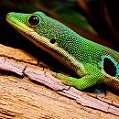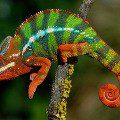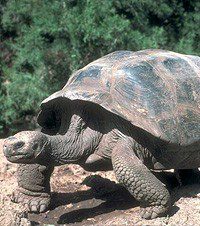
Far Eastern skink
Far Eastern skinks (lat. Plestiodon latiscutatus) give the impression of graceful and graceful creatures. The well-fed, but not overweight body of these lizards gradually turns into a long tail, and the smooth, as if polished scales resemble not so much reptiles as snakes. Skinks with very short legs are even more like snakes – such species are also found in nature, for example, spindle-shaped skinks. However, the Far Eastern skink is quite long-legged, although it does not belong to the genus of the same name. This rare and mobile creature is listed in the Red Book and lives on the island of Kunashir, amazing in nature and wildlife. In addition to him, there are other creatures protected by conservationists, for example, small-scaled and Japanese snakes.
Contents
Classification
Kingdom: Animals
Type: Chord
Class: Reptiles
Order: Scaly
Suborder: Lizards
Infraorder: Skinks
Family: Skink
Genus: Plestiodon, Plestiodon
Species: Far Eastern skink, Plestiodon latiscutatus
Appearance
The Far Eastern skink is the smallest representative of the genus with a body 6-8 cm long and a thin tail, the length of which can exceed the length of the body twice. Only some skinks living on the island of Kunashir grow to gigantic sizes by natural standards – 18 cm. The limbs of these lizards are well developed, the body is slender and as if elongated, and the muzzle is pointed. The scales of the Far Eastern skinks are somewhat reminiscent of fish and are distinguished by a lacquer sheen, especially at a young age. Slightly expanded rows of scales are located in the middle of the back, and scutes are also distinguished at the anterior edge of the auditory opening – they seem to be bent back and almost do not cover the ear canal. The lower eyelid of the lizard is also covered with opaque plates of skin, and large scutes are present in front of the cloacal fissure.
As for the coloration of the Far Eastern skinks, it alone deserves a whole scientific work, since it is distinguished by originality and variability. Young skinks are very bright lizards with a dark chestnut body with golden yellow stripes. Such a striped pattern reaches the very base of their tail, and in the region of the back of the head the central strip diverges into two branches, rushing to the front of the muzzle from zinc and there turning into bright spots. The tail of the Far Eastern skinks also stands out in color. Usually it is bright blue with a greenish tinge in the area of fusion with the body. Adult skinks are painted much more modestly – olive-gray on the back, dark brown stripes on the sides with a light upper border and a brownish tint on the head. And only during breeding, the males of the Far Eastern skinks are decorated with pink on the abdomen and bright coral on the throat.
Lizards begin to lose their juvenile bright coloration at about 4 years of age. The color of the body becomes more muted, the stripes on it seem to be blurred, and the tail loses its glossy blue. The lacquer shine of the scales, characteristic of young individuals, may also disappear. And in females, initially colored more modestly than males, bright parts of the body turn pale over the years, for example, bright brown strokes on the back disappear.
However, some features of the Far Eastern skinks are unchanged. This is a dense and elastic body due to the bone plates located under the scales and excellent mobility due to well-developed limbs. Because of these features, skinks are sometimes confused with snakes. As for the above sizes of lizards, they can also vary significantly within their limits. In particular, the smallest Far Eastern skinks are found on Kunashir Island, since the conditions for their habitat there cannot be called favorable.
However, during the breeding season, it is simply impossible not to notice the male skink, as he begins to actively demonstrate bright areas of his body to a more modest female. However, newborn skinks in this regard may well compete with adults. They are even more spectacular, decorated with terracotta or copper stripes, a dull green and slightly pinkish belly and a bright blue tail with greens. In general, the most incredible shades are combined in their coloring.
Distribution and habitation
 The skink family is significantly different from other reptiles. They are not as diverse as, say, agamas or iguanas, but they are completely unlike anyone else. At the same time, skinks can be found in the tropics, and in the subtropics, and in the south of the temperate zones. Specifically, the Far Eastern skink settled in almost all the Japanese islands, and within Russia – on the island of Kunashir in the Kuril ridge. Some zoologists also include Primorsky and Khabarovsk Territories in its habitat, but these habitats do not have exact confirmation. Perhaps the lizard was brought there by the sea current from the Japanese islands. As for the habitats of the Far Eastern skink, they are very diverse. These are rocky coasts, and the outskirts of coniferous forests, and clay and stone banks of a stream and small rivers, and sandy slopes with sparse vegetation, and even rocks near the sea coast. Sometimes the Far Eastern skink can be seen in ravines and open areas with sparse bamboo thickets, as well as on large coastal boulders or in oak groves. On the island of Kunashir, the habitats of lizards are directly connected with hot springs, near which skinks gather after hibernation. And of course, these reptiles, like many others, absolutely need shelters, for example, under stones, tree debris, turf.
The skink family is significantly different from other reptiles. They are not as diverse as, say, agamas or iguanas, but they are completely unlike anyone else. At the same time, skinks can be found in the tropics, and in the subtropics, and in the south of the temperate zones. Specifically, the Far Eastern skink settled in almost all the Japanese islands, and within Russia – on the island of Kunashir in the Kuril ridge. Some zoologists also include Primorsky and Khabarovsk Territories in its habitat, but these habitats do not have exact confirmation. Perhaps the lizard was brought there by the sea current from the Japanese islands. As for the habitats of the Far Eastern skink, they are very diverse. These are rocky coasts, and the outskirts of coniferous forests, and clay and stone banks of a stream and small rivers, and sandy slopes with sparse vegetation, and even rocks near the sea coast. Sometimes the Far Eastern skink can be seen in ravines and open areas with sparse bamboo thickets, as well as on large coastal boulders or in oak groves. On the island of Kunashir, the habitats of lizards are directly connected with hot springs, near which skinks gather after hibernation. And of course, these reptiles, like many others, absolutely need shelters, for example, under stones, tree debris, turf.
In general, skink lizards can be called cosmopolitans due to their fairly wide distribution around the world, unfortunately, the Far Eastern representative of the family belongs to endangered species. Outside of Russia, it can still be found only on the Japanese islands, and even there the number of the species is relatively small. And getting a Far Eastern skink for a home terrarium is even more difficult, just because of its rarity. And yet, connoisseurs of rare fauna respect this lizard, including for its pleasant appearance – expressive eyes and a body brightly colored in young individuals.
Behavior and lifestyle
After wintering, around mid-April, when the snow has not yet melted, Far Eastern skinks gather in groups near thermal springs or stay along the banks of various reservoirs. Lizards are active mainly during the day, and at night they hide in ready-made natural shelters or burrow into the ground. In the terrarium, it is especially interesting to observe how skinks dig out of the sand in the morning – first the very tip of the muzzle appears, then the whole head, and only after that the reptile gets to the surface. The approximate number of Far Eastern skinks in some of their habitats can be 1 lizard per 10 m2. By their nature, these creatures are not the most sociable, they do not immediately get used to a person, but when they get used to it, they quite calmly go into hands. True, in such communication, the skink with all its appearance shows not so much friendliness as condescension. The Far Eastern skinks also have another feature similar to other reptiles – they also know how to “lose” their tails, for example, in fights or falling into the clutches of predators. By itself, the bright coloring of this part of the body is aimed at distracting the enemy from other vital organs of the lizard. Being left in the wrong hands or paws, the tail of the reptile wriggles for some time, and while the enemy is distracted by this movement, the skink manages to hide.
In terms of nutrition, the instincts of the Far Eastern skink are quite predatory. He boldly hunts various insects and even molluscs in shallow water, and sometimes does not hesitate to catch smaller reptiles. But, of course, the Far Eastern lizard also has enemies, for example, a mink. And if we consider that the number of skinks is only a few thousand individuals, then the appearance of such an enemy within the limited limits of the island is fraught with destruction for the entire species.
Food
The diet of the Far Eastern skinks is quite diverse, and therefore they are not picky and unpretentious in food. The best treats for lizards are various invertebrates and insects: amphipods, grasshoppers, crickets, beetle larvae, caterpillars, arachnids, centipedes, molluscs, phalanges, etc. It is easy to feed the Far Eastern skink in captivity, it is enough to combine live food with pieces of meat. The jaws of the lizard are quite powerful, so that it easily crushes even hard shells of mollusks. However, in nature, skinks are able to catch and eat some smaller reptile relative. With large prey, they manage in a peculiar way, at first having properly patted and crushed it with their jaws. Sometimes Far Eastern skinks diversify their diet with plant foods, in particular, ripe mulberries that are found under trees. In a terrarium, it is recommended not to limit the diet of reptiles to only insects. They can be fed with boiled eggs, low-fat cottage cheese and fruits, and, of course, mineral supplements. Reptiles will readily eat insects that have been rolled in such top dressing. And it’s not difficult to get live food for the Far Eastern skinks. For this, insects that live in nearby gardens and parks are suitable.
Reproduction
 The reproduction of the Far Eastern skinks to this day remains the most mysterious area of u5bu6btheir life. The main data about him are derived on the basis of assumptions. In particular, it is assumed that the female skink makes only one clutch per season – in summer, at the end of July, and mating takes place around the end of May. It is also known that during the breeding season, skinks, like other reptiles, are prone to marriage ceremonies, expressed in demonstrations by males of their beauty and demonstrative fights for the favor of the female. Moreover, these fights are not always demonstrative. After them, many Far Eastern skinks lose their tails and remain with scars. As for, in fact, laying eggs, there is very little information about this. It is not known whether the female Far Eastern skink lays her eggs in the soil, or whether they develop directly in her oviducts. The skink genus is generally extremely diverse in terms of reproduction. There are viviparous species with a placenta, there are oviparous and at the same time carefully caring for their offspring skinks. For example, females of the broad-browed and five-lined skink are always near the clutch and periodically turn the eggs over, licking them with their tongue. Some representatives of the genus help the babies to be born, and then lick them additionally. About the female of the Far Eastern skink, it is only known that the number of eggs in the clutch is approximately 2-3 pieces, and the incubation period is XNUMX-XNUMX months in time. But what is the behavior of the female? It can be assumed that it resembles the behavior of a representative of any other species in the genus. Newborn Far Eastern skinks are born very slender with bright blue tails. In general, during the breeding season, adults prefer to stay near hot springs.
The reproduction of the Far Eastern skinks to this day remains the most mysterious area of u5bu6btheir life. The main data about him are derived on the basis of assumptions. In particular, it is assumed that the female skink makes only one clutch per season – in summer, at the end of July, and mating takes place around the end of May. It is also known that during the breeding season, skinks, like other reptiles, are prone to marriage ceremonies, expressed in demonstrations by males of their beauty and demonstrative fights for the favor of the female. Moreover, these fights are not always demonstrative. After them, many Far Eastern skinks lose their tails and remain with scars. As for, in fact, laying eggs, there is very little information about this. It is not known whether the female Far Eastern skink lays her eggs in the soil, or whether they develop directly in her oviducts. The skink genus is generally extremely diverse in terms of reproduction. There are viviparous species with a placenta, there are oviparous and at the same time carefully caring for their offspring skinks. For example, females of the broad-browed and five-lined skink are always near the clutch and periodically turn the eggs over, licking them with their tongue. Some representatives of the genus help the babies to be born, and then lick them additionally. About the female of the Far Eastern skink, it is only known that the number of eggs in the clutch is approximately 2-3 pieces, and the incubation period is XNUMX-XNUMX months in time. But what is the behavior of the female? It can be assumed that it resembles the behavior of a representative of any other species in the genus. Newborn Far Eastern skinks are born very slender with bright blue tails. In general, during the breeding season, adults prefer to stay near hot springs.
Sources of
http://www.sevin.ru/
http://ru.wikipedia.org/
http://www.zooclub.ru/
http://www.zooschool.ru/





